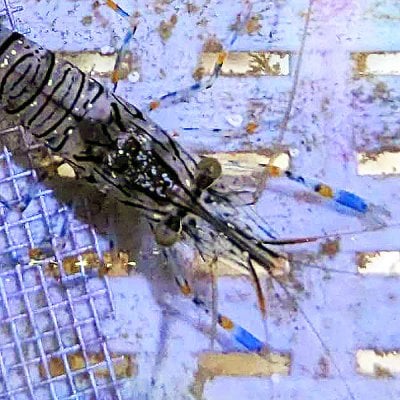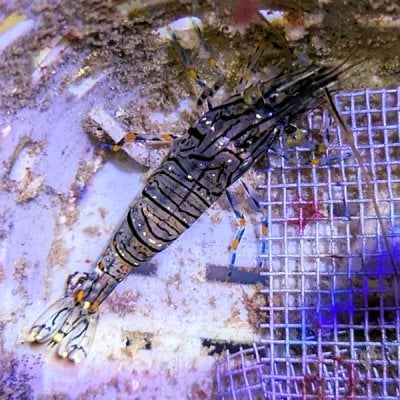Palaemon elegans - The Biota captive bred Elegant Rockpool Shrimp is a super hardy detritivore for your clean up crew that will eat leftover food, algae, and detritus. This clear shrimp has contrasting black stripes, neon blue claws, and yellow spots. They can grow to almost 2.5" long.
This is a new species bred by Biota North Carolina. Not much is known about their behavior in aquariums, but North American aquarists who have put wild shrimp in their tanks reported that they did not bother corals or other inverts. One aquarist even reported that the shrimp cleaned his hands when he was cleaning the tank.
Aquacultured shrimp tend to be on the smaller side at sale size than wild caught shrimp, but the trade off is that they're hardier and better suited to aquarium life. When you buy captive bred shrimp, you know you're getting a young shrimp that will work hard for its entire lifespan. They tend to grow very quickly when introduced to the home aquarium. After acclimation, it helps to introduce them to the tank when the lights are off, and do try to place them gently in the safety of the rock work rather than introducing them to the empty water column. These shrimp are most active at night, so it's normal that you won't see them during the day. If you have larger fish in your tank, we recommend keeping them in an acclimation box for a time.
Biota fan Ivan Bozic says, "They are 100% reef safe, they live here in the Adriatic, Croatian reefers keep them in reef tanks for years, excellent scavengers they can reach with their claws deep in the rocks for food leftovers or dead animals, the females produce a large number of babies that are excellent food for fish and coral.
the problem with locally collected [as opposed to captive bred] is that they are very delicate to temp change, it's only at summer you can transfer them from nature to your tank when temp is the same in winter they rarely survive the transition from 6-11c to 24c."

 shop.thebiotagroup.com
shop.thebiotagroup.com


This is a new species bred by Biota North Carolina. Not much is known about their behavior in aquariums, but North American aquarists who have put wild shrimp in their tanks reported that they did not bother corals or other inverts. One aquarist even reported that the shrimp cleaned his hands when he was cleaning the tank.
Aquacultured shrimp tend to be on the smaller side at sale size than wild caught shrimp, but the trade off is that they're hardier and better suited to aquarium life. When you buy captive bred shrimp, you know you're getting a young shrimp that will work hard for its entire lifespan. They tend to grow very quickly when introduced to the home aquarium. After acclimation, it helps to introduce them to the tank when the lights are off, and do try to place them gently in the safety of the rock work rather than introducing them to the empty water column. These shrimp are most active at night, so it's normal that you won't see them during the day. If you have larger fish in your tank, we recommend keeping them in an acclimation box for a time.
Biota fan Ivan Bozic says, "They are 100% reef safe, they live here in the Adriatic, Croatian reefers keep them in reef tanks for years, excellent scavengers they can reach with their claws deep in the rocks for food leftovers or dead animals, the females produce a large number of babies that are excellent food for fish and coral.
the problem with locally collected [as opposed to captive bred] is that they are very delicate to temp change, it's only at summer you can transfer them from nature to your tank when temp is the same in winter they rarely survive the transition from 6-11c to 24c."

Elegant Rockpool Shrimp
Palaemon elegans - The Biota captive bred Elegant Rockpool Shrimp is a super hardy detritivore for your clean up crew that will eat leftover food, algae, and detritus. This clear shrimp has contrasting black stripes, neon blue claws, and yellow spots. They can grow to almost 2.5" long. This is a...

















